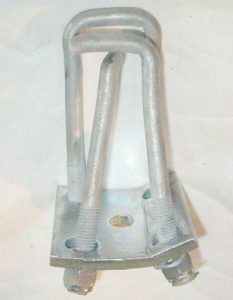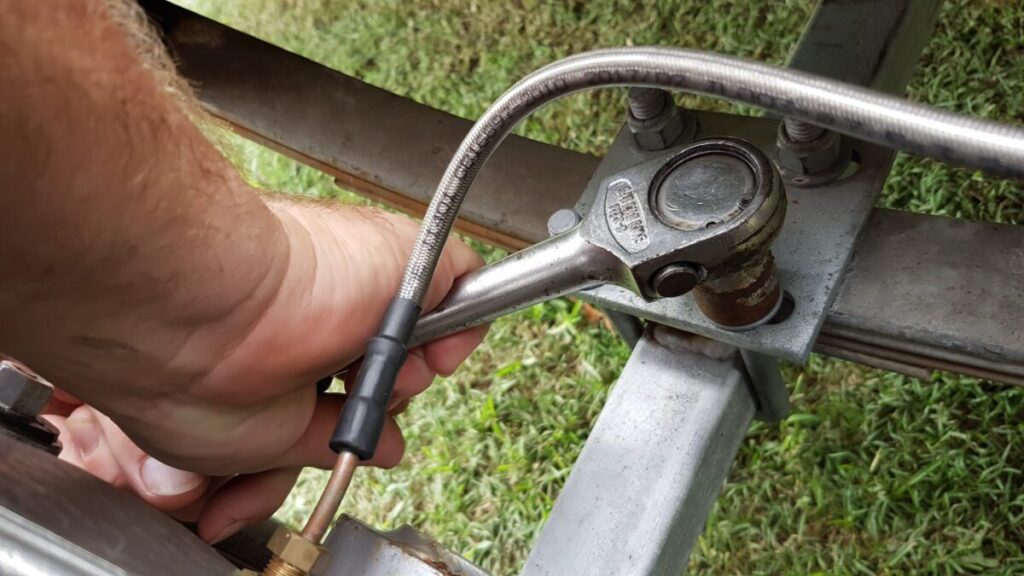
Loose Axle U-Bolts cause Highway Havoc
Loose axle u-bolts cause highway havoc for unsuspecting caravaners. The reality of not checking your rig before heading on your family holiday can quickly become a nightmare.
The axle in the photo is a heavy-duty 50mm square, Australian-made axle with 12″ electric backing plates and AL-KO drums. All the equipment is heavy-duty and of good quality, so the problem did not arise from cheap equipment. The trailer attached to this axle was also nearing its total capacity of 4.5t, so you can imagine how severe this accident was.
The cause of the accident was found to be loose u-bolts. In the picture above, do you notice how the u-bolt axle clamp is still intact on the right-hand side of the trailer? The leaf spring has broken; however, if the u-bolts were adequately tightened, the u-bolt clamp should retain some of the spring.
The left side of this axle is severely damaged. The u-bolts have become so loose that the axle has moved back, possibly under shock loading, and detached from the u-bolt clamping system.
The axle then rattled inside the spring camber area until it broke the spring. This led to a bent axle and the axle exiting the trailer undercarriage. How to avoid this disastrous event? A straightforward solution is to ensure you tighten the nuts on your u-bolts.
New Caravan, Camper or Trailer
If you have recently purchased a new trailer, do a small inspection and crawl under your rig with a spanner; see if you can tighten the u-bolt nut by 1/4 turn.
Check the fish plate and note if it is excessively bent under tension.
This simple check might just save you a broken spring and a few nights in a different town whilst repairs are undertaken.
If you are unlucky enough to suffer a loose u-bolt, the axle will likely be dislodged from your spring and move towards the back of the spring – causing it to break.
A simple check with a spanner, as recommended above, will not allow this problem to fester.
U-Bolts and Australian Standards for Caravans
There is no Australian standard for u-bolts used in the caravan or trailer industry.
The standard u-bolt most commonly used is SS400 grade steel that is coupled with a 1/2″ BSW thread. Although higher tensile steels are available, the industry is unmoved by the demand for a better standard of clamping axle and spring to the caravan chassis.
The engineers and production team at Couplemate™ are investigating and testing higher-grade steels for use within the caravan industry – ones that do not require re-tightening at the first service. As an essential chassis component critical for safe travel, Couplemate™ are dedicated to investing in research and development for this product.
Often, manufacturers (such as AL-KO or ourselves) specify torque settings for caravan and trailer u-bolts. This creates a problem when dealers and customers ask for torque settings. It also creates issues removing the hydrogen embrittlement that often causes u-bolts to bend or break easily.
Review our Heavy Duty 16mm U-bolt Kits here
- 45mm x 16mm Square ElectroGal U-Bolt
- 50mm x 16mm Square ElectroGal U-Bolt
- 60mm Round HD U-Bolts
- 65mm Round HD U-Bolts
Typical Sizes and Ratings of U-Bolts are:
- 1/2″ BSW – up to 1500kg per axle
- 5/8″ BSW – up to 2250kg per axle
- 5/8″ UNF High Tensile – over 2250kg
FAQ: Can I cut my U-Bolt to size?
Buyers of u-bolts often do not measure or take a sample of a current u-bolt to their trailer shop when purchasing new ones. As such, some customers opt to manually cut their bolt to size. This procedure sounds straightforward; however, the nylon inside the nylock will melt when given enough heat. The melted plastic inside the nylock will cause the nut to unwind on the highway.
The fix is to measure the u-bolt and cut it before installation. An ounce of care is worth a tonne of cure.
Couplemate U-Bolt Testing
As shown above, the idea of a faulty u-bolt while on the road is pretty scary. But this issue has one simple solution.
U-bolts manufactured by Couplemate™ have been tested to rupture at 23 tonnes. This is best evidenced by this photo on the right from our testing laboratory. The test was undertaken with a 200t press utilising a 50mm square K1045 axle section. We estimated the forces needed to bend this axle when exiting the undercarriage were more than 23t.
So, why can U-Bolts be a Major Cause of Accidents?
Loose axle u-bolts are among the most underrated issues in the caravan and camper industry. People can easily miss checking their u-bolt condition and how tightly they are secured. Indeed, this can be a leading cause of the nightmare accidents you see on the highway.
The image below was taken when Steve, our Founder, checked his boat trailer for the first time in many years.
Although you cannot see it in the image, Steve had to re-tighten the nuts on his boat trailer by half a turn. This is quite significant, which surprised him at that moment. However, retightening his u-bolts gave him peace of mind for the journey he embarked on.
Knowing this, Couplemate™ encourages you to check the tightness of your u-bolts regularly. If you’ve got a spare moment, perhaps even tighten them with a socket today (before you forget). Likewise, next time you go to get your caravan, trailer or camper serviced, consider the following questions:
- When was the last time you tightened your u-bolts?
- Did your mechanic check them on your previous service?
- Did you ask him to check the u-bolts?
If you found this article helpful, I invite you to leave a comment at the bottom of the page. You can also continue reading here, which gives further insight into u-bolts and their role in causing chaos.
News Articles – Caravan and Trailer U-Bolts
- Stretching U-Bolts Cause Caravanning Problems
- 5 Things to Know: Mounting Springs Above Your Axle
- Why U-bolts Maybe the Major Cause of Accidents
- Intro to Road Vehicle Compliance (CTA)


Suggestion; fit retainer nuts as secondary once torque value is reached or recess a situation into the retainer plate that will effectively capture and retain the nut (s) at least to a degree thereby reducing the requirement to check but not eliminating it. If this situation is such a problem then why on earth didn’t manufacturing companies allow for this, afterall a lot of older retired operators are out there suggesting that they are not exactly overly flexible enough to go crawling under rigs checking stuff that shouldn’t in all reality, be set up to fail. .
Tight and NEW NYLOCK nuts